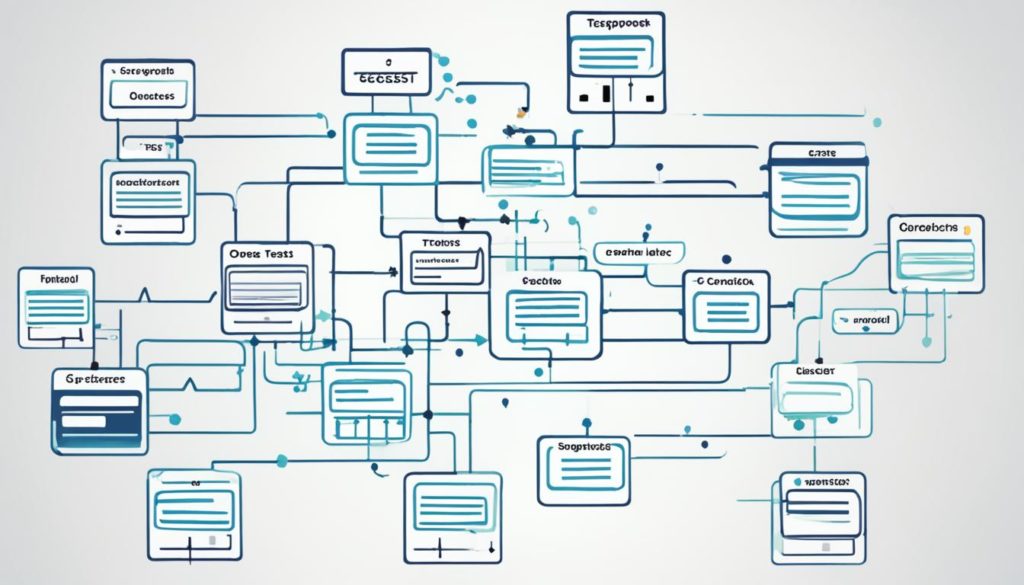
Did you know that about 70% of software defects happen during design and implementation? Most of these issues could be caught by strong test case design. Good test cases spot defects and ensure we are testing everything well. This makes our software testing process better and more reliable. Whether we’re talking about testing strategies, test automation, or making great apps, knowing how to design test cases is key.
Making detailed test cases helps us to better understand what a software needs. It lets us focus on important tests and use different methods wisely. This greatly boosts the quality of the software we make.
Key Takeaways
- Effective test case design can identify up to 70% of defects early in the development process.
- Understanding requirements is foundational to creating robust test cases.
- Prioritizing test cases helps focus on critical areas first.
- Using a mix of testing strategies ensures comprehensive coverage and effective defect detection.
- Incorporating test automation can streamline the testing process and improve efficiency.
Introduction to Test Case Design
Test case design is a way to set up conditions for checking if an app works right. It’s key for software testers, helping them make sure the app does what it’s supposed to. Essentially, it’s about making a plan to test the software’s features and functions.
A test case is like a recipe for testing. It has unique parts like an ID, steps, and expected results. This makes testing organized and thorough. Different types of tests (like checking if it works, is easy to use, or runs fast) are combined to make a full picture.
Test cases are detailed from start to finish, with steps and what to expect all laid out. This detail is important. It makes clear what we’re testing and what result we should get. Test cases are made to fit the development stage they’re for.
Test cases matter a lot. They’re like a quality check, making sure the software matches what the customer wants. They help catch bugs early, making the development process smoother.
Good test cases have specific parts, like the test’s ID, steps, expected results, and what to do next. Writing them well is a skill. It includes making them simple, clear, and able to find and fix problems easily. By focusing on designing good test cases, teams can set up the project’s testing phase without hiccups. This saves time and effort later on.
Each test case is like a mini-check on the software’s health. Success means the app is doing what it should. The cleaner and smarter the test cases, the better the software’s quality. This is why knowing how to design tests is a big help in making great software.
Key Techniques for Effective Test Case Design
When it comes to making a test plan, using the right techniques is key. It helps make sure we cover everything well and do things efficiently. Let’s look at four important methods to improve how we plan our tests.
Equivalence Partitioning
Equivalence Partitioning breaks input data into groups where each group gets its own test case. This way, we can see which inputs behave the same, cutting down on unnecessary tests. This method makes our testing more focused and thorough. It ensures we check every group, making our test planning better. For more details on writing good test cases, visit here.
Boundary Value Analysis
Boundary Value Analysis looks at the important edges of input ranges to test them closely. Since many bugs hide at these edges, this method is crucial. It helps us find defects that random testing might miss, making our applications more reliable.
Decision Table Testing
Decision Table Testing is great for double-checking complex logic. With decision tables, we can map out all the possible conditions and actions, making sure we cover everything. It’s especially useful when there are lots of input and output possibilities. This method helps us navigate complex logic, making our software do what it’s supposed to.
Use Case Testing
Use Case Testing focuses on how the system is used in real life. It makes sure we test all user paths to see if they match what we planned. Including Use Case Testing in our plan means practical scenarios are covered, which makes users happier and the system better. For tips on writing great test cases, check out here.
With techniques like Equivalence Partitioning, Boundary Value Analysis, Decision Table Testing, and Use Case Testing, we can make our test planning rock-solid. We ensure our software testing is reliable, efficient, and covers everything.
The Benefits of Good Test Case Design
Good test case design is about more than just finding bugs. It makes sure all parts of the software are checked well. This helps make the software better.
By making test cases well, we find problems early. This early detection saves time and money after the software is out. It also helps us use our resources better.
Designing test cases the right way cuts costs. It makes the testing process more efficient by focusing on what’s important. This saves both money and effort on testing.
- Improved test coverage across the project spectrum.
- Enhanced software quality by detecting issues early.
- Considerable cost savings through optimized testing processes.
Creating good test cases lets us use them again. This saves time when we work on new projects. We’re able to test more effectively because we’re using tests we know are good.
Overall, making top-notch test cases improves test coverage and software quality. It also makes the software-making process cheaper and smoother. It’s a win all around.
Best Practices in Test Case Design
Embracing top practices in test case design is key for top-notch software. We’ll explore four main points that boost our testing. This, in turn, leads to better results.
Understanding Requirements
We need to know the software’s needs to make good test cases. Being clear helps our tests cover every situation. Plus, it lets us make sure the software meets its requirements.
Prioritizing Test Cases
It’s smart to test key features first to use time wisely. By prioritizing, we check the most important functions deeply. This makes the software more reliable overall.
Incorporating Positive and Negative Testing
Testing both the expected and the unexpected is essential. Positive tests check if things work as they should. Negative tests make sure the software handles wrong inputs well. This method finds various issues, making the software stronger without errors.
Using the SMART Approach
The SMART way is great for designing test cases. It stands for Specific, Measurable, Achievable, Relevant, and Time-bound. This makes our tests clear and focused. It also makes the testing process more efficient and effective.
| Approach | Benefits |
|---|---|
| Understanding Requirements | Ensures comprehensive coverage and compliance |
| Prioritizing Test Cases | Maximizes efficiency, focuses on critical areas |
| Positive and Negative Testing | Enhances robustness, uncovers different issues |
| SMART Approach | Creates clear, goal-oriented test cases |
Tools and Techniques for Enhancing Test Case Design
Good test case design is key for top-notch software. The right tools and techniques make a big difference here. Various testing tools can make creating test cases easier. They help you check more things while putting in less work. Let’s talk about how Ranorex Test Automation and DesignWise Coverage Dial can make quality testing better.
Ranorex Test Automation
Ranorex is a great help for today’s QA teams. It lets us run test scripts, handle test data, and make tests smoother. The Gherkin editor is easy to use for making detailed test cases. This ensures our tests are full and steady. Ranorex quickens our test cycle and lets us dive deep into code checks. This all supports strong test case design for better testing.
DesignWise Coverage Dial
DesignWise is another handy tool, making test coverage better. The Coverage Dial shows us where our tests check well or not. It lets us see unique actions and results. This helps make sure software behaves right in all situations, like Decision Table Testing. It’s great for tricky rules or systems that rely on logic.
In summary, using strong testing tools like Ranorex and DesignWise can lift our tests’ quality. These tools, with the right methods, build a better testing setup. They make sure our tests are clear, broad, and followable. This fits with our aim of making top-grade software.
Conclusion
In our journey through designing effective test cases, we’ve seen its importance. It helps make sure products are of good quality. We use methods like pairwise testing and state transition testing. They help find errors in system changes by trying many input combos.
Doing thorough testing for every single option is hard. But with a good plan, we can catch most problems. It’s critical to follow the best ways, like keeping test steps simple and focusing on certain tests. Tools like the BrowserStack Test Management Tool make creating and handling tests easier. This is important because there are many devices people use to get online worldwide.
We also use various strategies, like boundary value analysis and guessing errors. These strengthen our test plans and show we’re dedicated to quality. Being ready to change our tests when we need to is key for dependable software. By always improving our strategies and using tools like ReQtest, we aim for great software that makes users happy.
FAQ
What is test case design in software testing?
Test case design is how we make a structure to test if software meets its goals. It’s key for checking enough parts and ensuring the program works right.
Why is test case design important in quality assurance?
Test case design is crucial for software quality. It finds errors, makes tests more focused, and improves how we test. This leads to better software.
What techniques are commonly used in test case design?
Techniques like Equivalence Partitioning and Decision Table Testing are common. They help make tests cover more, find more bugs, and run smoother.
How does Equivalence Partitioning enhance test case design?
Equivalence Partitioning makes testing more efficient by grouping similar inputs. This way, we test everything while using fewer specific cases.
What is Boundary Value Analysis, and why is it used?
Boundary Value Analysis looks at input extremes where a lot of bugs hide. It ensures we test critical points well. This finds issues regular tests might not catch.
What benefits does Decision Table Testing offer?
Decision Table Testing is great for complex situations. It covers every logic combination, which is perfect for systems with complicated decisions.
How does Use Case Testing work?
Use Case Testing checks if software supports actual user tasks. It makes sure the system responds well to real-life tasks people will do.
What are the benefits of a well-constructed test case design?
Well-made tests do more than find bugs. They cover more, cost less, and make sure the software is good. They catch issues early and help tests run smoothly.
What best practices should be followed in test case design?
Knowing requirements and choosing tests based on importance is key. Add both good and bad scenarios. The SMART method helps to make clear, effective tests.
How does prioritizing test cases improve the testing process?
Putting important tests first is smart. It finds major issues early, saving time and money on fixes after the software is out.
What tools can enhance test case design and automation?
Tools like Ranorex and DesignWise make designing and running tests better. Ranorex is a full test suite. DesignWise has features for smarter testing.
Future App Studios is an award-winning software development & outsourcing company. Our team of experts is ready to craft the solution your company needs.










